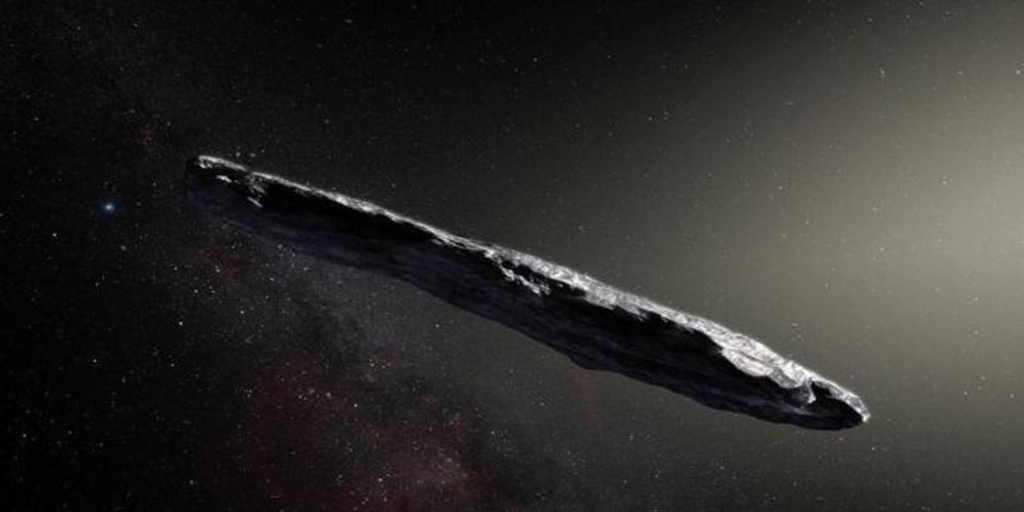
the mystery of Oumuamua, the first object from beyond the Solar System detected by human technology, seems to be coming to an end. At least that’s what the astrochemist Jennifer Bergner, from the University of California, and the astrophysicist Darryl Seligman, from Cornell University, believe, who say they have solved the riddle of the unusual acceleration of this object whose origin is still not agreed upon. . The secret would be in a natural process with strange peculiarities caused by the release of molecular hydrogen. The conclusions have just been published in the journal ‘Nature’.
Oumuamua was discovered in October 2017 leaving our Solar System. At first, it was thought to be a comet, although the idea was dismissed almost immediately, as the object lacked a tail and a coma, the ‘hair’ that wraps around the nucleus and is made of material evaporated from its surface.
For this reason, the researchers came to the conclusion that it could be an asteroid, although this explanation did not fully answer the reason for its strange trajectory: the object accelerates its speed, instead of decreasing it, as expected. In fact, there were studies that pointed out that their erratic behavior was due to a collision with another object. There was also the exotic hypothesis that it was a stranded spacecraft sent by another civilization long ago – a theory that remains strongly supported by Harvard astrophysicist Avi Loeb.
Now, this new study proposes that this body is actually a fragment of a planetesimal – the germ of a planet in formation – that was completely ejected from its star system.
Decrypting ‘Oumuamua
The first thing that puzzles is its shape: Oumuamua is long and thin as a cigar, measuring up to 400 meters long. No other comet or asteroid in the Solar System has this shape. This enigmatic object also spins as it goes, like a bottle on its side. And, while the object appears to be ice-free and emits no gases that we can detect, as a comet would, its trajectory cannot be explained by gravity alone, as an asteroid’s trajectory would.
Outgassing as their ice sublimates gives comets an additional source of acceleration, consistent with what astronomers observed with Oumuamua. This suggests that it is in some way similar to both a comet and an asteroid.
In the years since his visit, scientists have determined that Oumuamua is likely a detached fragment of a planetesimal. Such collisions are not unknown in a forming planetary system; in fact, our own Earth is believed to have been crushed by another planet-sized object as big as Mars, breaking off a fragment from which our Moon originated. In Oumuamua’s case, the fragment was completely expelled from his system.
A theory that is not new
In 2020, Seligman co-authored a paper already proposing that Oumuamua’s acceleration could be attributed to the sublimation of molecular hydrogen (H2). Molecular hydrogen is very difficult to detect in space, since it does not emit or reflect light; if Oumuamua were outgassing molecular hydrogen, we wouldn’t be able to see it the way we usually see debris from cometary activity.
However, other studies denied the possibility that this body was a molecular hydrogen iceberg. Therefore, Bergner and Seligman reconsidered the model to determine how the object could contain (and sublimate) this gas, which would respond to its unusual acceleration.
They found that the explanation is plausible through the irradiation of a body rich in water ice. As ionizing radiation hits the object, radiolytic processes would split the water molecules to produce molecular hydrogen. “In this model -they write in their article- Oumuamua began as an icy planetesimal that was irradiated at low temperatures by cosmic rays during its interstellar journey, and experienced heating during its passage through the Solar System.”
A heating process and an annealing process (by which the object is heated to certain temperatures and then gradually cools down) would explain why the molecular hydrogen escaped and produced this extra acceleration.
However, the theory will be impossible to test with Oumuamua, as it is now so far out of range of our telescopes. Still, the researchers note that future findings from other interstellar travelers may prove their hypothesis. “Future detections of small bodies with non-gravitational acceleration and weak coma could provide insight into the origins of Oumuamua,” Bergner and Seligman write, “despite the fact that it has long since departed the Solar System.”
